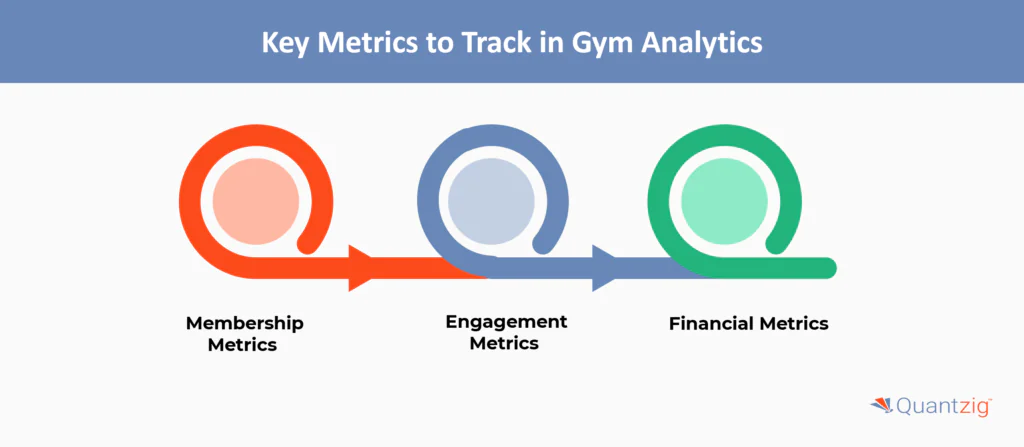Written By: Vice President, Data Analytics, Quantzig.
Table of Contents
Table of Contents
- Introduction to Data Analytics in the Fitness Industry
- Overview of Gym Analytics
- The Importance of Gym Analytics
- Why Data Analytics Matter for Fitness Businesses
- The Key Benefits of Using Analytics in the Fitness Industry
- Fitness Industry Trends to Watch Out
- Conclusion
Introduction to Data Analytics in the Fitness Industry
The health and fitness industry in the US is booming for all the good reasons- changing lifestyles, healthy food habits, rise in use of smart wearables and fitness trackers, and a well-informed, growing customer base. Due to many such factors promoting healthy lifestyles, those operating in the fitness industry have started witnessing an incremental growth in revenue along with an expanding customer base. To those in the business, this means a rise in unstructured data sets that hold valuable insights that could potentially transform business functions.
For many such reasons, advanced fitness or gym analytics solutions that help analyze and effectively manage huge volumes of customer data sets have become an indispensable part of every business strategy. In this context, fitness data analytics solutions or data analytics in the fitness industry that leverage data obtained from smart wearables, social media platforms, fitness equipment, research reports, and customer feedback forms play a crucial role in improving business processes. However, what truly brings about a difference in business strategy and growth, lies in how businesses utilize these data sets to improve the overall experience of their customers.
Request a demo to experience the meaningful insights we derive from data through our analytical tools and platform capabilities. Schedule a demo today!
Request a Free DemoWhat is Gym Analytics?
Gym analytics fundamentally entails the collection, organization, and analysis of data pertaining to various operational facets of a gym. This includes metrics such as member attendance, engagement levels, retention rates, equipment utilization, revenue streams, profitability, effectiveness of marketing campaigns, and customer satisfaction. The objective is to convert raw data into valuable insights that inform strategic decision-making and foster operational enhancements. Equipped with the appropriate tools and methodologies, gym owners and managers can achieve a comprehensive understanding of their business, enabling data-driven decisions that yield measurable outcomes.
What is the Importance of Gym Analytics?
Gym analytics in the fitness business matter because they give fitness companies the data they need to make wise decisions. Gym owners and managers can better target their offerings, enhance member experiences, and improve services by gaining insights into member behavior, preferences, and patterns through data analysis. Furthermore, gym analytics help companies track revenue and profitability, evaluate the effectiveness of marketing campaigns, spot growth prospects, and outperform the competition. Utilizing analytics is not only a luxury in today’s data-driven world, but it is also essential for the fitness industry to survive and thrive.
Why Data Analytics Matter for Fitness Businesses


In today’s highly competitive fitness landscape, data analytics has emerged as a transformative force, empowering businesses to make informed decisions, enhance customer experiences, and drive sustainable growth. As a B2B content writing expert, I will delve into the reasons why data analytics is a strategic imperative for fitness businesses.
1. Unlocking Actionable Insights
The fitness industry generates a wealth of data from various sources, including membership management systems, wearable devices, and customer feedback. By leveraging advanced data analytics, fitness businesses can uncover valuable insights that were previously hidden. These insights can inform strategic decisions, optimize operations, and personalize offerings to better meet the evolving needs of their clientele.
2. Enhancing the Customer Experience
Data analytics enables fitness businesses to develop a deeper understanding of their customers’ preferences, behaviors, and pain points. Armed with these insights, businesses can tailor their services, class schedules, and marketing strategies to deliver a more personalized and engaging customer experience. This, in turn, fosters stronger customer loyalty and drives higher retention rates.
3. Driving Operational Efficiency
Data analytics can also help fitness businesses streamline their operations by identifying areas of inefficiency, optimizing resource allocation, and predicting demand patterns. From equipment utilization to class scheduling, data-driven insights empower fitness businesses to make data-backed decisions that enhance productivity, reduce costs, and improve overall operational performance.
4. Gaining a Competitive Edge
In an industry where innovation and agility are key to success, data analytics provides fitness businesses with a distinct competitive advantage. By leveraging data to anticipate market trends, personalize offerings, and optimize business strategies, fitness businesses can stay ahead of the curve and differentiate themselves in a crowded marketplace.
5. Unlocking New Revenue Streams
Data analytics can also uncover new revenue-generating opportunities for fitness businesses. By analyzing customer data, businesses can identify untapped market segments, develop targeted product or service offerings, and explore innovative business models that capitalize on emerging trends and customer preferences.
6. Embracing the Data-Driven Future of Fitness
As the fitness industry continues to evolve, data analytics will play an increasingly pivotal role in shaping the success and sustainability of fitness businesses. By embracing the transformative power of data, fitness businesses can unlock a world of possibilities, delivering exceptional customer experiences, driving operational excellence, and positioning themselves for long-term growth and profitability.
Data analytics has emerged as a game-changer for fitness businesses, providing them with the tools and insights necessary to thrive in an increasingly competitive and dynamic industry. By leveraging the power of data, fitness businesses can unlock actionable insights, enhance customer experiences, drive operational efficiency, gain a competitive edge, and unlock new revenue streams.
As the fitness industry continues to evolve, embracing data analytics will be a critical success factor for businesses looking to stay ahead of the curve. By investing in data analytics capabilities and fostering a data-driven culture, fitness businesses can position themselves for long-term growth and success in the ever-changing landscape of the fitness industry.
Get started with your complimentary trial today and delve into our platform without any obligations. Explore our wide range of customized, consumption driven analytical solutions services built across the analytical maturity levels.
Start your Free Trial nowWhat are the Key Metrics to Track in Gym Analytics?

Here are the key metrics to track in gym analytics:
1. Membership Metrics
- Membership Growth Rate: The rate at which new members are joining the gym.
- Membership Retention Rate: The percentage of members who renew their membership over a given period.
- Member Lifetime Value: The total revenue a member is expected to generate over the lifetime of their membership.
2. Engagement Metrics
- Class Attendance Rate: The percentage of members attending scheduled classes.
- Equipment Usage Rates: The utilization of gym equipment by members.
- Digital Engagement: Metrics like app usage, website traffic, and social media engagement.
3. Financial Metrics
- Monthly Recurring Revenue (MRR): The predictable, subscription-based revenue the gym generates each month.
- Profit Margin: The percentage of revenue that remains as profit after expenses.
- Average Revenue Per Member (ARPM): The average monthly revenue generated per member.
By closely tracking these key performance indicators, gym owners and managers can gain valuable insights to optimize operations, improve the member experience, and drive business growth. The data-driven approach empowers data-driven decision making to enhance the overall success of the fitness business.
What are the Key Benefits of Using Analytics in the Fitness Industry?


The fitness industry has experienced significant growth in recent years, driven in part by the increasing adoption of data analytics. By leveraging data-driven insights, fitness businesses can optimize their operations, enhance customer experiences, and drive growth. Here are six key benefits of using analytics in the fitness industry:
1. Personalized Training Programs
Data analytics enables fitness centers to create highly personalized training programs tailored to individual goals, preferences, and performance. By analyzing past attendance, engagement, and workout data, trainers can develop routines that resonate with each client’s unique needs.
2. Optimized Scheduling and Equipment Usage
Analytics helps fitness businesses track equipment usage patterns and optimize class schedules to meet demand. This ensures efficient utilization of resources, preventing over or under-booking of classes.
3. Targeted Marketing Strategies
By understanding client demographics, preferences, and engagement patterns, fitness centers can develop targeted marketing strategies that reach the right audience with the right message. Data-driven insights help in tailoring communication and offerings to different segments of the client base.
4. Improved Retention Rates
Analyzing what motivates clients and what they value in their fitness experience can significantly increase retention rates. By understanding engagement patterns and feedback, gyms can tailor their services to better meet client expectations and foster long-term loyalty.
5. Predictive Analytics for Health Trends
Historical data analysis enables fitness centers to predict health trends and seasonal patterns. This allows for proactive planning, such as offering targeted classes or promotions based on anticipated demand.
6. Enhanced Customer Experience
Data-driven insights help fitness businesses personalize the customer experience, from tailored training programs to real-time performance monitoring. By leveraging wearable devices and integrated gym equipment, trainers can provide more nuanced feedback and make on-the-spot adjustments to workout plans.
In conclusion, the fitness industry is harnessing the power of data analytics to drive growth, optimize operations, and enhance the customer experience. By integrating data from various touchpoints and leveraging predictive analytics, fitness businesses can gain a competitive edge and stay ahead of industry trends.
Fitness Industry Trends to Watch Out


Here’s why fitness analytics has played a crucial role in the growth of the fitness industry:
Today irrespective of the vertical you operate, leveraging customer analytics is crucial to grow your business and succeed in the long run. Using advanced data and fitness data analysis solutions, businesses in the fitness industry can analyze customer behavior and make data-driven decisions to drive business value.
1. Deliver Unique Experiences
Though your customers are unaware of the role they play in improving your business, the data they leave behind plays a valuable role in improvising your services. This wealth of information can be analyzed to offer customized services to enhance the customer journey.
2. Curate Personalized Marketing Messages
The good news about leveraging data and analytics in the fitness industry is that it helps you gain a clear picture of your customers by offering valuable insights that truly matter from a business perspective. Using these insights, businesses operating in the fitness industry can devise customized marketing messages and strategies to cater to the needs of different customer groups.
3. Integrate Data from Different Touchpoints
To remain competitive in the rapidly growing fitness industry businesses must invest in an integrated personal fitness data analytics infrastructure that collates and analyzes data from generated from various sources. Analyzing and integrating customer data from different touchpoints can help you gain a holistic understanding of their needs by turning data into business acumen.
4. Wearable Technology
According to Quantzig Experts, the fitness wearables market is expected to continue its rapid growth, reaching $114.36 billion by 2028. Devices like the Oura Ring and Apple Watch are providing more advanced biometric tracking, allowing users to monitor their health and wellness in greater detail. Fitness businesses can leverage this trend by integrating wearable data to create more personalized training programs and enhance the customer experience.
5. Hybrid Fitness Models
The COVID-19 pandemic has accelerated the adoption of hybrid fitness models, blending in-person and online workout options. Gyms and studios are offering a mix of live-streamed classes, on-demand content, and in-person sessions to cater to evolving consumer preferences. This trend allows fitness businesses to reach a wider audience and provide more flexibility for their clients.
6. Resurgence of Free Weight Strength Training
There is a growing awareness of the benefits of strength training with free weights, beyond just bodybuilding or powerlifting. Gyms that provide welcoming, non-intimidating free weight training areas are poised to capitalize on this trend as more people seek to improve their overall fitness and functional strength.
Experience the advantages firsthand by testing a customized complimentary pilot designed to address your specific requirements. Pilot studies are non-committal in nature.
Request a Free TrialConclusion
In conclusion, the fitness industry is experiencing substantial growth by harnessing the power of data and analytics. By leveraging data analytics in the fitness industry, fitness businesses can gain valuable insights into customer behavior, preferences, and trends. This enables them to make data-driven decisions, optimize their operations, and deliver personalized experiences to their customers. Data and analytics also play a crucial role in improving member retention, as businesses can identify patterns and factors that contribute to member churn and take proactive measures to address them. Furthermore, data-driven marketing strategies allow fitness businesses to target their audience more effectively and tailor their offerings to meet specific needs. Overall, the integration of data analytics in the fitness industry is driving growth, enhancing customer satisfaction, and enabling businesses to stay ahead in a highly competitive market.




